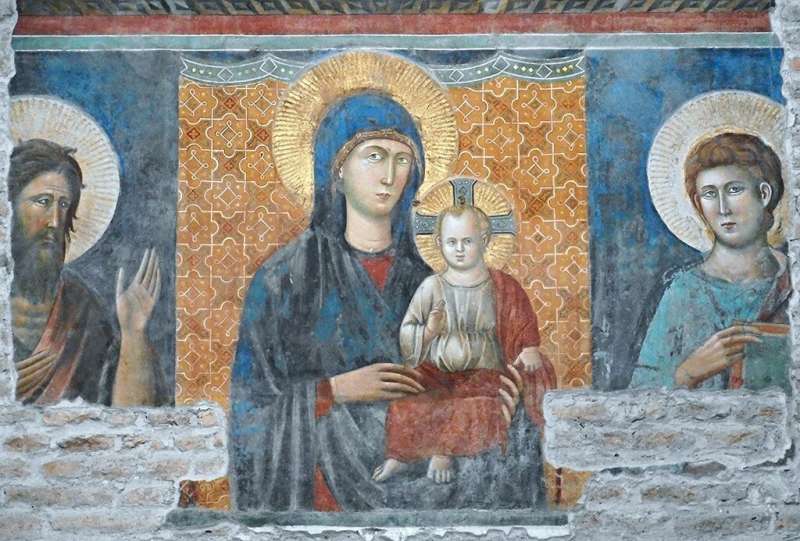This article has been reviewed according to Science X's editorial process and policies. Editors have highlighted the following attributes while ensuring the content's credibility:
fact-checked
trusted source
proofread
Frescoes, in a flash: Researchers create frescoes in a single day

In medieval Europe, before the rise of oil paintings, fresco was a popular religious painting technique. Many artworks across Europe, hundreds of years old, utilize this method and constitute an important part of cultural heritage. Michelangelo's famous Sistine Chapel ceiling and Fra Angelo's Annunciation in Italy are perhaps two of the most well-known examples of frescoes. But how exactly does the fresco technique work?
A fresco is painted on a wet slaked lime plaster wall with natural rock pigments. The plaster, consisting of calcium hydroxide, reacts with water vapor and carbon dioxide in the atmosphere to form calcium carbonate. It gradually forms a protective coating over the pigments, preserving the painting. In addition, it increases the mechanical strength of the plaster. However, this process takes place over decades, making frescoes a rarely practiced art form.
In this regard, a group of researchers from the Department of Life Science and Applied Chemistry at the Nagoya Institute of Technology in Japan, including Professor Shinobu Hashimoto, Mr. Keitaro Yamaguchi, and Prof. Yuji Iwamoto, rapidly fabricated frescoes through a ceramic cold sintering technique that was "geomimetic", or inspired by the natural rock formation processes taking place in the Earth's crust.
The team's work was published in Ceramics International.
Prof. Hashimoto explains the idea behind geomimetic ceramics. "This hardening method is named so because it imitates the formation of sedimentary rocks in the crust. It employs a warm press to heat calcium hydroxide powder up to 300 °C under the high pressure of several hundred megapascals. These conditions harden the powder, forming the base material for frescoes."
The researchers painted on the fabricated bases using red iron oxide pigment powder because of its low environmental impact. Next, they performed supercritical carbon dioxide treatment. Supercritical carbon dioxide is a fluid form of carbon dioxide that forms when it is heated and held at a very high temperature and pressure. The application of supercritical carbon dioxide in their technique helped form calcium carbonate on the painted surface.
To ensure that the pigment stayed immobilized on the surface, the researchers subjected the painting to a warm press before the carbon dioxide treatment. The resultant calcium hydroxide layer exhibited superior visible light transmittance and better pigment immobilization.
Further, to ensure an even coating and sufficient translucency, the researchers mixed the pigment and calcium hydroxide powders for painting instead of powder coating the fresco. The heavier iron-based pigment particles in the mixture settled and deposited on the base, while the calcium hydroxide remained on top and covered the surface uniformly, ultimately resulting in an even calcium carbonate coating.
The researchers found that a 1:10 pigment-to-hydroxide ratio by mass was sufficient to immobilize the pigment particles. Adding more hydroxide made the painting whitish. They analyzed the structural characteristics of the resultant frescoes using scanning electron microscopy and energy dispersive X-ray spectroscopy to confirm the calcium and iron element distribution.

Lastly, the researchers measured pigment color differences among various mixing ratios with a colorimeter. The 1:10 novel mixture ratio showed appreciable color development. In fact, its pigment color was brighter than even the original pure pigment. The researchers suggest that the calcium hydroxide particles dispersed the red iron oxide pigments, reducing their aggregate size. That, in turn, increased the transmitted light intensity.
The results highlighted in this work will enable the rapid production of frescoes designed with calcium hydroxide mixed pigments, warm pressing, and supercritical carbon dioxide treatment. This fresco technique can also be used for the production of pigmented pictures on pottery, which could act as a push towards new, energy-efficient, unfired pottery technology.
Prof. Hashimoto puts into perspective the enormity of the present work. "Using our technique, a fresco, a historical art painting that takes hundreds of years to form, was successfully created in one day. This finding could facilitate unfired pottery technology for a low-energy society. It is important to pay attention to traditional fields as past technologies can also contribute to the latest advancements."
More information: Keitaro Yamaguchi et al, Rapid fabrication of frescoes using a geomimetic ceramic formation process, Ceramics International (2021). DOI: 10.1016/j.ceramint.2021.11.022
Provided by Nagoya Institute of Technology





















